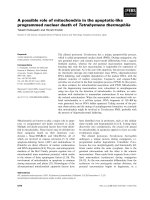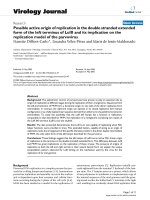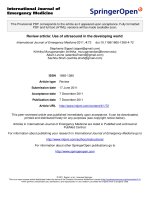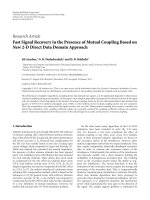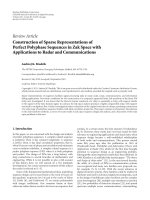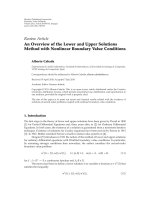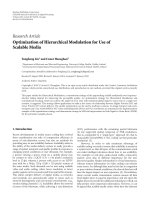Báo cáo toán học: " Review article: Use of ultrasound in the developing world" potx
Bạn đang xem bản rút gọn của tài liệu. Xem và tải ngay bản đầy đủ của tài liệu tại đây (178.14 KB, 43 trang )
This Provisional PDF corresponds to the article as it appeared upon acceptance. Fully formatted
PDF and full text (HTML) versions will be made available soon.
Review article: Use of ultrasound in the developing world
International Journal of Emergency Medicine 2011, 4:72 doi:10.1186/1865-1380-4-72
Stephanie Sippel ()
Krithika Muruganandan ()
Adam Levine ()
Sachita Shah ()
ISSN 1865-1380
Article type Review
Submission date 17 June 2011
Acceptance date 7 December 2011
Publication date 7 December 2011
Article URL />This peer-reviewed article was published immediately upon acceptance. It can be downloaded,
printed and distributed freely for any purposes (see copyright notice below).
Articles in International Journal of Emergency Medicine are listed in PubMed and archived at
PubMed Central.
For information about publishing your research in International Journal of Emergency Medicine go to
/>For information about other SpringerOpen publications go to
International Journal of
Emergency Medicine
© 2011 Sippel et al. ; licensee Springer.
This is an open access article distributed under the terms of the Creative Commons Attribution License ( />which permits unrestricted use, distribution, and reproduction in any medium, provided the original work is properly cited.
Review article: Use of ultrasound in the developing world
Stephanie Sippel
1
, Krithika Muruganandan*
1
, Adam Levine
1
and Sachita Shah
1
1
Department of Emergency Medicine, Brown University, 593 Eddy Street, Providence
RI, 02903, USA
*Corresponding author:
Email addresses:
SS:
KM:
AL:
SS:
Abstract
As portability and durability improve, bedside, clinician-performed ultrasound is seeing
increasing use in rural, underdeveloped parts of the world. Physicians, nurses and
medical officers have demonstrated the ability to perform and interpret a large variety of
ultrasound exams, and a growing body of literature supports the use of point-of-care
ultrasound in developing nations. We review, by region, the existing literature in support
of ultrasound use in the developing world and training guidelines currently in use, and
highlight indications for emergency ultrasound in the developing world. We suggest
future directions for bedside ultrasound use and research to improve diagnostic capacity
and patient care in the most remote areas of the globe.
Background
It is generally accepted that in rural and remote areas of low- and middle-income
countries (LMICs) diagnostic imaging is often insufficient, and in some instances
completely lacking [1]. Over the past decade, however, the use of clinician-performed,
hand-carried, bedside ultrasound has gained increasing popularity as a useful imaging
modality worldwide, helping to boost the diagnostic capacity of rural district hospitals in
resource-limited settings. The increase in ultrasound services provided by nonradiologists
is likely due to several factors, including the increased affordability, availability,
portability and durability of ultrasound machines. In addition, machine design has
become more user-friendly for novice users with fewer knobs and streamlined design for
quick comprehension of key features. Many new laptop-based machines are now in
production. Improvements in battery life for hand-carried machines, and the lack of film,
chemical developers and dedicated technicians, allow for use of ultrasound in health
missions to remote areas of the developing world. Because of this evolution in
technology and the growing body of literature to support its use, ultrasound has gained
increasing recognition as a valuable diagnostic tool for resource-limited settings by the
ministries of health in LMICs, several non-governmental organizations and the World
Health Organization (WHO).
Experience and prior study
There have been a multitude of small studies depicting novel uses of ultrasound in the
developing world, but only a few studies have looked at the impact of ultrasound use on
clinical management and patient outcomes, and whether ultrasound may be a sustainable
modality for use in LMICs.
In a study from Rwanda, ultrasound was introduced at two rural district hospitals, and the
impact on patient care was assessed by asking providers to identify if ultrasound changed
patient management plans. Of the first 345 ultrasounds performed, the majority of scans
were performed for obstetrical purposes (102), followed by abdominal (94), cardiac (49),
renal (40) and pulmonary (36), along with a few procedural usages, soft tissue and
vascular exams. In 43% of patient cases, ultrasound findings changed the initial patient
management plan, with the most common changes cited as: performing a surgical
procedure, medication changes, clinic referral and canceling of a planned surgical
procedure [2].
In another study by Kotlyar et al., ultrasound changed patient management in 62% of
cases at the major tertiary care center in Monrovia, Liberia. The greatest impact on
patient management was seen with first trimester obstetric ultrasound, followed by
FAST, cardiac and second/third trimester ultrasound exams; the smallest impact was seen
in RUQ and gynecologic studies [3].
In another study of patients in the Amazon jungle, a group of American emergency
physicians found that ultrasound examinations changed treatment in 28% of patients,
including appropriate referrals for more definitive care in some cases and avoiding a
potentially dangerous 2-day evacuation for additional medical care in others [4]. The
consulting physician’s differential diagnosis was narrowed after reviewing the ultrasound
results in 72% of cases, with diagnostic certainty achieved in 68% of cases.
In 2004, a study by radiologists sought to demonstrate that portable ultrasound could
enhance the medical management and clinical outcomes of patient care in a variety of
clinical settings (surgeon’s office, hospital operating room and clinics) in the Sekondi-
Takoradi area, Ghana. In clinic settings, the most frequent ultrasound examinations were
musculoskeletal (46%), with the remainder being obstetric, pelvic and genitourinary. In
the hospital setting, abdominal, pelvic and genitourinary ultrasounds were the most
frequent exams done to assess bladder masses, prostate and uterine size, and kidney
abnormalities. A total of 67 ultrasound examinations were performed with abnormal
findings in 54 (81%). One hundred percent of these abnormal ultrasounds were thought
to add to the clinical diagnosis, and 40% (27) influenced the outcome or decision
regarding treatment for these patients [5].
Similar results have also been seen in larger studies. In western Cameroon, the Ad Lucem
Hospital of Banka-Bafang conducted a retrospective review of 1,119 ultrasound
examinations and their effect on diagnosis and treatment. Abnormal findings were
present in 78% of the cases, and 67.8% of the ultrasounds were judged to be useful for
diagnosis, while only 4% were felt to be noncontributory. Ultrasound provided the
diagnosis in 31.6% of the cases, and confirmed a prior diagnosis or allowed a differential
diagnosis to be excluded in 36.2% of the cases. In a subpopulation of confirmed
diagnosis (via tissue pathology, additional imaging tests, endoscopy, surgical specimen or
laboratory diagnosis), approximately half of the diagnoses made by ultrasound had not
been previously considered [6].
Despite its limitations, the impact of ultrasound is beginning to become clear, and this
tool has become indispensable for the examination of cardiac, abdominal, obstetric,
vascular, traumatic and musculoskeletal complaints in the developing world. Given the
prevalence of poverty-related diseases, such as tuberculosis, malaria and dehydration due
to diarrheal illness, in the developing world, it is no surprise that emerging uses for
ultrasound in LMICs include these diseases [7-9]. We summarize here, by region, some
of the highlights of diagnostic ultrasound research for specific diseases in resource-
limited settings in LMICs.
Africa
Egypt
Intrauterine growth retardation (IUGR) is a major contributing factor to perinatal
mortality and morbidity in developing countries, and ultrasound may play an important
role in early identification of pregnant mothers at risk. In 1988, Mahran et al.
demonstrated an 11.8% rate of neonatal growth retardation in 828 pregnant women in
Cairo, Egypt. In this group, antenatal ultrasound was able to predict 89.7% of these
cases, while only 34.7% were predicted by fundal palpation [10].
Gambia
In a 2004 study in Gambia, physicians used a hand-held ultrasound to identify high-risk
patients with cardiovascular disease and hypertension. Of the 1,997 patients seen, 17%
(342) were found to have elevated blood pressure, and all of these patients underwent
echocardiography to identify left ventricular hypertrophy, as a marker for those at highest
risk of a cardiovascular event. Sixty-five percent of this hypertensive population
demonstrated left ventricular hypertrophy by ultrasound and were started on
antihypertensive medications. Patients with borderline hypertension also underwent a
cardiac ultrasound examination and were started on antihypertensive medications only if
they had evidence of left ventricular hypertrophy. Through this screening and the
identification of high-risk hypertensive patients, ultrasound enabled a more effective use
of limited healthcare resources [11].
Tanzania
In a district hospital in Karagwe, Tanzania, ultrasound services were studied to determine
the impact on obstetric care. Nurse midwives, trained in basic obstetric ultrasound, were
available to perform studies 24 h/day, whereas specialized ultrasonographers performing
advanced ultrasound (including fetal biometrics) were only available during daytime
hours. Five hundred forty-two patients with suspected abnormal findings were scanned
over 1 year. When evaluating for twins, fetal heart rate or fetal positioning, the basic
exam performed by the midwives had 100% agreement with the sonographer. Overall,
ultrasound aided in the diagnosis of 39% (212) of patients and changed management
plans in 22% (121). This study demonstrated that 24-h availability of basic obstetric
ultrasonography performed by midlevel providers could be implemented in a rural
hospital setting to lessen the workload of a specialist sonographer while improving
patient care [12].
Zambia
In rural Zambia, 21 midwives participated in a pilot program for focused obstetric
ultrasound to determine whether ultrasound skills could be imparted to nurse midwives.
Obstetric ultrasound instruction given by ultrasound fellowship-trained emergency
physicians included fetal presentation, fetal heart rate, placental location, number of
gestations and assessment of gestational age. Over the 6-month training period, 441
ultrasounds were performed, with the main abnormal findings being non-vertex
presentation (61%), multiple gestations (24%) and no fetal heart rate (8%). Ultrasound
findings prompted a change in the clinical decision-making in 17% of cases. At the 1-
year follow-up, ultrasound use continued, with an average number of ten ultrasound
examinations per week per midwife, and 100% of the midwives reported that ultrasound
helped their practice and changed their management [13].
Zambia/Congo
In a large retrospective study from the 1990s, abdominal ultrasound was used to define
ultrasound findings of HIV through evaluation of 900 HIV-positive adults in the major
tertiary referral hospitals of Lubumbashi, Congo, and Lusaka, Zambia. Ultrasound exams
were performed by local practitioners for evaluation of various complaints, including
pain, fever and organomegaly, and results of these ultrasounds were compared to age and
sex-matched HIV-negative patients. Compared to HIV-negative patients, those with
AIDS who underwent an ultrasound examination had significantly higher rates of
splenomegaly (24% vs. 35%), hepatomegaly (22% vs. 35%), retroperitoneal and
mesenteric lymphadenopathy (11% vs. 31%), biliary tract abnormalities, such as
gallbladder wall thickening (12% vs. 25%), gut wall thickening (5% vs. 15%) and ascites
(9% vs. 22%). The authors concluded that focused abdominal ultrasound in patients with
HIV and AIDS can be a useful tool for diagnosing associated complex gastrointestinal
pathology [14].
Malawi
Uncertainties regarding accurate gestational age may contribute to the difficulty in
accurately assessing the role preterm birth plays in neonatal mortality in the developing
world. Ultrasound may help to characterize the true magnitude of this public health
concern. In a 2005 study, local practitioners performed ultrasound exams on 512 pregnant
women prior to 24-week gestation presenting for prenatal care at a rural health center
(Namitambo) or hospital (Thyolo) in Malawi, and provided an estimation of their
gestational age. In this cohort, 20.3% of mothers delivered prematurely prior to 37 weeks
of gestation, and these infants born between 32 and 37 weeks were twice as likely to die
as their full-term counterparts (6.9% vs. 3.4%). This study introduces the idea that early
obstetric ultrasound may allow for a more accurate assessment of the actual gestational
age at the time of birth, thus demonstrating the true prevalence of preterm birth in the
developing world [15].
South Africa
South African hospitals experience some of the highest trauma volumes in the world, and
most have limited imaging capabilities, leading to significant diagnostic and therapeutic
challenges. A study at the Ngwelezane Hospital, a busy referral center in rural KwaZulu-
Natal, South Africa, examined the use of the FAST (focused assessment with sonography
in trauma) exam on blunt and penetrating trauma victims. Over a 12-month period, 72
FAST scans were performed (52 for blunt trauma, 20 for penetrating trauma) with 15
positive scans (20.8%). The overall specificity of the FAST scan was 100%, with a
sensitivity of 71.4%, but its sensitivity in penetrating trauma alone was much poorer at
62.5%. This study highlights the valuable role FAST scanning can play in the rapid
assessment and timely transfer of appropriate trauma patients to referral hospitals [16].
Asia: India
The diagnosis of abdominal tuberculosis is often difficult in the developing world due it
its vague clinical features, mimicry of other diseases, and expensive/time consuming
workup with CT scan and laparotomy. In Uttar Pradesh, India, investigators sought to
assess the accuracy of ultrasound for diagnosis of abdominal tuberculosis in symptomatic
patients co-infected with HIV. A retrospective review of 2,543 patients evaluated
ultrasound use in an antiretroviral clinic. Patients with persistent fever, change in bowel
movements, diarrhea or abdominal distention received an ultrasound evaluating Tb-
related pathology such as lymphadenopathy (nodes >15 mm), organomegaly or multiple
small abscesses/hypoechoic lesions in abdominal solid organs, bowel wall thickening,
peritoneal nodules, mesenteric thickening or ascites as well as other abdominal
pathologies. Of the 2,453 patients in an antiretroviral clinic, 373 were evaluated by
ultrasound, of which 244 showed features suggestive of abdominal tuberculosis, with
lymphadenopathy as the most common finding (64.8%), followed by splenomegaly
(27.9%), hepatomegaly (20.1%) and bowel wall thickening (6.1%). Ultrasound was
repeated at the end of antitubercular therapy, showing resolution of abnormal findings,
which suggests this imaging modality may be useful in the diagnosing and monitoring of
HIV-positive patients with abdominal tuberculosis [9].
North America: Mexico
In an attempt to characterize cardiac disease prevalence in the developing world,
American cardiologists used hand-carried ultrasound in outpatient clinics in rural San
Blas and El Fuerte, Mexico. They performed cardiac ultrasound exams on 126 patients
referred to the clinic by their primary care doctors for hypertension, chest pain, dyspnea,
edema, murmurs, suspected congenital abnormalities, palpitations and syncope, of which
68% (86) exams were abnormal. The most common abnormal findings included
significant valvular disease, left ventricular hypertrophy, dilated aortic root/increased
chamber size, congenital abnormalities (including bicuspid aortic valve, PDA, atrial and
ventricular septal defects), ventricular systolic dysfunction and regional wall motion
abnormalities. In 93% of patients, hand-held ultrasound provided useful information that
helped to clarify the clinical problem, in 63% of cases, ultrasound confirmed the cardiac
origin of a symptom and in 90% of cases it made conventional echocardiography
unnecessary. Hand-held ultrasound can provide useful diagnostic information in the
evaluation of patients with potential cardiac disease in resource-limited settings [17].
Training in ultrasound
As demonstrated in the studies highlighted above, ultrasound can significantly impact the
diagnosis and management of patients in LMICs. However, ensuring the sustainability of
ultrasound programs in resource-limited settings will also require the implementation of
successful training programs for local practitioners and the development of markers for
quality assurance.
In 1998, the WHO established standards in ultrasound training and recommended that an
appropriate curriculum be adopted for the training of practitioners in the use of diagnostic
ultrasound [18]. However, there have been no standardized approaches to length of
training, curriculum for general practitioners, qualifications of trainers or mechanism of
training published in the literature.
For example, successful ultrasound training courses implemented in LMICs have varied
in length from as little as 4 days to several months. In 2005, Adler et al. introduced a
portable ultrasound machine into the Lugufu refugee camp in Kigoma District, Tanzania,
and conducted an intensive 4-day ultrasound training course for the local healthcare
providers [19]. Shah et al. conducted a training course in Rwanda with a length of 9
weeks in 2008 [20].
Trainees in the various study populations have ranged from clinical officers, nurses and
nurse midwives
to fully trained physicians. Trainers have similarly varied in these
studies, including resident physicians, emergency physicians, radiologists, cardiologists
and ultrasound-fellowship trained emergency physicians.
The curriculum and method of training described in the literature for general ultrasound
in LMICs range from broad to focused, depending on the goals of the program and
research study. In the Adler study [19], the training course consisted of morning
interactive classroom sessions addressing basic ultrasound physics, use of ultrasound
machine knobs and reviews of specific clinical ultrasound applications, including FAST,
abdominal aorta, hepato-biliary, first trimester pregnancy ultrasound, fetal position and
gestational age, ultrasound-guided procedures, soft tissue, basic cardiac exam and renal
ultrasound. The afternoons and early evening were spent doing hands-on evaluations of
inpatients and outpatients at the Lugufu hospital and clinics. During the 2-year study
period, 547 ultrasound exams were performed on 460 patients. The most common
ultrasound exam performed was for obstetrical purposes (24%), followed by abdominal
ultrasounds (22.7%), pelvic ultrasound (21.9%), renal (9.9%) and RUQ exams (9.0%).
Building upon this training model, Shah et al. [20] developed an ultrasound training
program in rural Rwanda that spanned 9 weeks, and included lectures, hands on practice
sessions and scan time during daily ward rounds conducted by the instructor with the
local practitioners. Topics covered included ultrasound physics, obstetric ultrasound (first
trimester ectopic and molar pregnancies, estimation of gestational age, and evaluation of
the fetal position, cervix and placenta), echocardiography (rheumatic disease, mitral
stenosis, estimation of ventricular function and pericardial effusion), hepatobiliary
ultrasound (including evaluation for amebic abscess, echinococcal cysts, cholecystitis),
renal ultrasound, and advanced topics such as deep venous thrombosis, vascular access,
skin and soft tissue evaluation and procedural guidance. This study added bimonthly
review sessions, and appointment of an “ultrasound coordinator” at each hospital site
who was entrusted with the care of the ultrasound machine, gel and supply ordering,
ultrasound logbook upkeep and uploading images from the ultrasound to their personal
computer. Through this ultrasound coordinator, physicians were able to send images via
e-mail for ongoing quality assurance after the training period ended.
Overall, the available literature suggests that a short but intensive training period is
sufficient for preparing clinical officers, nurses and physicians alike to perform basic
ultrasound exams, especially if the training program includes both lecture and practical
experience, and provides opportunity for continued upkeep of skills through review
sessions and ongoing quality assurance after the training period ends.
Indications for ultrasound in resource-limited settings
While a long list of potential indications for ultrasound in low resource settings exists and
has filled a textbook [21], we focus here on the main emergency ultrasound indications
that may help reduce morbidity and mortality in the developing world.
Emergency obstetric ultrasound
Ultrasound can be a valuable tool in all trimesters of pregnancy. In the first trimester of
pregnancy, ectopic pregnancy is a leading cause of mortality in women in LMICs,
requiring early identification and prompt intervention. Since clinical signs and symptoms
are not reliable, ultrasound can play a pivotal role in its diagnosis. Early in their
pregnancy, many women seek care for abdominal pain and/or vaginal bleeding. Bedside
ultrasound by Emergency Physicians (EPs) in the United States has provided rapid
exclusion of ectopic pregnancy by identifying intrauterine pregnancy (visualizing the
yolk sac or fetal pole). In one study, instituting a protocol for bedside ultrasound by EPs
in evaluating patients with first trimester bleeding decreased the delay to diagnosis of
ectopic pregnancy from 43% to 29% and decreased the rate of missed ruptured ectopic
pregnancy from 50% to 9% [22]. Another study, evaluating EPs’ bedside ultrasound in
125 patients showed a 96% agreement with formal radiology department ultrasound,
suggesting this is a rapidly learned skill for non-radiologists and non-obstetric specialists.
EP ultrasound for diagnosing ectopic pregnancy had a sensitivity and specificity of 90%
and 88%, respectively, and a negative predictive value of 100% [23]. Adding a right
upper quadrant view to search for free fluid in Morison’s pouch aids in the diagnosis of a
ruptured ectopic pregnancy. Free fluid is a good predictor of necessitating operative
intervention and decreases time to such inventions [24, 25].
Estimating gestational age in second and third trimester pregnancy can be helpful in the
diagnosis and management of preterm labor and can be performed successfully by non-
obstetric specialists with a high degree of sensitivity. In one study, after a didactic session
and a proctored exam, eight EPs evaluated a sample of pregnant patients (14-40 weeks)
showing a high correlation of fetal biometrics obtained by EPs compared with the
ultrasound technicians (correlation of 0.96 for biparietal diameter and 0.97 for femur
length) [26]. In this study, ultrasound was more accurate than fundal height measurement
in determining fetal viability (fetal age >24 weeks) with an accuracy of 96% versus 80%.
Internationally, obstetric ultrasound has been used to train local healthcare workers and
midwives. As previously discussed, focused maternal ultrasound training for midwives
has been successful in Zambia [13], and other studies from Burma and Bangladesh show
local health practitioners can be trained in estimating gestational age using ultrasound. In
a refugee camp on the Thai-Burmese border, four local healthcare workers were trained
in OB ultrasound in 2009. Evaluation of fetal biometrics for 349 patients showed good
inter-observer reliability between healthcare workers and the expatriate doctor [27]. In
Bangladesh, nine paramedics (with no previous ultrasound experience) were trained and
evaluated on their accuracy of measuring fetal biometrics. Results of the evaluation of
180 pregnant women (7-31 weeks) showed an inter-observer error rate that was quoted to
be within an acceptable range for ultrasound technicians [28].
In addition to evaluating ectopic pregnancy and estimating gestational age, bedside
ultrasound can also be used to evaluate gynecological infections, i.e., tubo-ovarian
abscess, by identifying complex adnexal masses, pyosalpinx or echogenic pelvic fluid on
ultrasound [29]. These specific obstetric and gynecological ultrasound exams have a high
yield for the diagnosis and management of reproductive-age females in the developing
world.
Trauma ultrasound
FAST (Focused Assessment with Sonography in Trauma) has been used routinely in the
management of trauma patients worldwide as a rapid, noninvasive way to evaluate
patients with thoracoabdominal trauma. The FAST scan can be performed within minutes
at the bedside and can help in resource-limited settings with decisions regarding which
patients require immediate operative care. The FAST exam has been shown to decrease
the time to operative intervention in a randomized controlled trial as compared to a
standard clinical evaluation. Patients that received FAST had a 64% decrease in the time
to operative intervention, and decreased complication rates and hospital length of stay
[30]. The sensitivity of FAST scans in detecting intraperitoneal hemorrhage is 75-78%
and its specificity is 98-100%, suggesting it is a useful tool to confirm the presence of
hemoperitoneum and hemopericardium [31, 32]. Clinically, the FAST scan is particularly
beneficial in the hypotensive trauma patient whose source of hypotension is unclear [33].
In addition to its use in resource-limited settings during routine clinical care, FAST is
also useful in disasters and mass casualty scenarios. When evaluating multiple severely
injured patients in a disaster setting, FAST can aid in rapid triage of injured patients and
guide operative care. For example, FAST during wartime in Lebanon was employed as a
tool for soldiers suspected of having abdominal injuries to help triage them to operative
intervention, computed tomography (CT) or clinical observation [34]. FAST has also
been used by medical relief workers during multiple natural disasters in the past 2
decades, including the earthquake in Armenia in 1988 [35], Wenchuan, China, in 2008
[36], and Haiti in 2010 [37], and the tsunami in Indonesia in 2004 [38]. FAST is also
valuable in a resource-limited setting where there is limited access to computed
tomography. The utility of FAST was evaluated in a government hospital in rural
KwaZulu Natal in South Africa, as mentioned above [16].
Ultrasound evaluation for pneumothorax has been added to the FAST exam (Extended
FAST) and has proven to be a powerful additional adjunct to trauma ultrasound. Studies
comparing ultrasound with supine chest x-ray has demonstrated that ultrasound has
greater sensitivity in the diagnosis of pneumothorax. The sensitivity and specificity of
ultrasound range between 86.2-98.1 and 97.2-100%, respectively, while the sensitivity
and specificity of chest x-ray are between 27.6-75.5% and 100%, respectively [39, 40]. A
study from the military literature evaluating the performance of non-physicians
(physician assistants, medics, veterinary technicians and a food service inspector)
performing ultrasound for pneumothorax showed great success. After a brief
instructional session, 22 non-physicians evaluated 44 hemi-thoraces of porcine models
(some with induced pneumothoraces), showing a sensitivity of 95.4%, specificity of
100%, PPV 100% and NPV 95.6% [41]. Evaluation of pneumothorax has been extended
to prehospital care in Europe [42], suggesting that ultrasound for pneumothorax is an
easily acquired skill, even for novice sonographers.
Despite the encouraging literature, it is important to remember that all ultrasound,
including the FAST exam, is dependent on the training and experience of the clinician. A
study evaluating non-radiologist physicians (surgeons and emergency medicine
physicians) found that while the initial error rate for FAST scans was 17%, it fell to 5%
after performing ten exams [43]. Another study evaluating surgeons, radiologists and
technicians found that the learning curve for FAST leveled off after 30 exams [44].
Cardiac ultrasound
Focused echocardiography has an important role in assessing patients with cardiovascular
compromise. It is useful in diagnosing pericardial effusion, assessing left ventricular
ejection fraction, assessing volume status in patients with shock and delineating the
etiology of cardiovascular collapse. In one study in the US evaluating patients with
dyspnea of unclear etiology (i.e., after ruling out congestive heart failure, pneumonia,
COPD, pulmonary embolism), pericardial effusion was found in 13.6% of patients [45].
The incidence of such effusions may be higher in communities where HIV and
tuberculosis are more prevalent. Research supports the ability of non-cardiologist
physicians to accurately diagnose pericardial effusions. In a large study evaluating 515
high-risk patients with dyspnea, 103 had a pericardial effusion. EPs’ bedside
echocardiography obtained the diagnosis with a sensitivity and specificity of 96% and
98%, respectively [46]. In a hemodynamically unstable patient, early diagnosis of cardiac
tamponade can expedite bedside ultrasound-guided pericardiocentesis [47, 48].
Ultrasound is also used in the evaluation of shock as a measure of cardiac contractility.
The literature has shown that EPs’ estimation of the left ventricular ejection fraction
correlates well with cardiologists’ estimation of LVEF [49, 50]. In patients with pending
cardiovascular collapse or cardiac arrest, ultrasound is able to identify reversible or
correctable causes. In a study of 20 patients in PEA or near PEA arrest, bedside
echocardiography diagnosed 8 patients with pericardial effusion, 3 of which were in
tamponade requiring emergency pericardiocentesis [51]. In cardiac arrest, ultrasound can
guide when to cease resuscitation efforts because of the high correlation between lack of
organized cardiac motion on ultrasound and lack of return of spontaneous circulation [52,
53].
Ultrasound evaluation for deep venous thrombosis and pulmonary embolism
Evaluating for deep vein thrombosis (DVT) is useful in patients with leg swelling/pain,
crush injuries, prolonged immobilization, recent surgery and other pertinent risk factors.
In resource-limited settings, due to the hypercoagulability of HIV-positive patients and
the lack of routine prophylactic anticoagulation of hospitalized patients, bedside
diagnosis of DVT is especially important in providing timely care. Ultrasound evaluation
for DVT has been shown to be successful by nonvascular specialists ranging from novice
to advanced users of ultrasound, and can be performed in just a few minutes at the
patient’s bedside [54, 55]. A study evaluating 56 emergency clinicians (attending
physicians, residents and midlevel providers) after didactic training showed an initial
sensitivity and specificity of 70% and 89%, respectively. The sensitivity improved to
100% for clinicians who performed three or more scans [56]. A more recent study
showed that physicians trained with a brief focused module could achieve sensitivity of
100% and specificity of 99% for detection of DVT with bedside ultrasound [57], with
similar studies supporting a high correlation with radiologically performed DVT
evaluations. In addition, although echocardiography cannot effectively rule out
pulmonary embolism, in the case of a massive or sub-massive pulmonary embolism,
echocardiography may show right ventricular enlargement, tricuspid regurgitation, and
paradoxical septal shift into the left ventricle or a ventricular thrombus [58, 59].
Ultrasound in surgical emergencies
In settings with limited access to surgical care and computed tomography, ultrasound can
help to identify true surgical emergencies, allowing efficient use of resources. Given the
burdens of patient transportation in the developing world and cost associated with
unnecessary consultations and imaging tests, bedside ultrasound can help streamline
diagnosis and patient care.
While access to specialized vascular surgery may be limited, ultrasound diagnosis of
abdominal aortic aneurysm (AAA) as a cause for abdominal pain may allow for rapid
identification of surgical candidates and save resources for further diagnostic workup
once a diagnosis has been reached. Testing for syphilis, a cause of AAA, can be initiated
for the patient and their partners, and in cases where vascular surgery is not available,
other risk factors such as hypertension can be controlled to reduce the risk of rupture.
Prior studies of ultrasound for diagnosis of AAA have shown high rates of sensitivity and
specificity [60, 61].
Surgical hepatobiliary diseases such as cholecystitis, may be rapidly diagnosed by non-
radiologist healthcare providers using ultrasound. The emergency medicine literature
suggests clinicians performing bedside ultrasound can attain a high sensitivity and
specificity for detection of cholecystitis compared with formal ultrasound radiology [62,
63]. Ultrasound can also be used to diagnose liver abscesses with a sensitivity of 86%, to
guide aspiration/percutaneous drainage and to follow resolution during treatment [64,
65].
While evaluation of appendicitis in the developed world relies heavily on computed
tomography and surgical consultation, in resource-limited settings the diagnosis is often
made by generalist clinicians based on history and physical exam alone. Ultrasound may
be useful in these settings to improve diagnostic capacity, especially in pediatric patients
or patients in whom a non-therapeutic appendectomy would be more risky. In a meta-
analysis comparing ultrasound and CT (pooling 9,356 children and 4,341 adults),
ultrasound demonstrated a sensitivity and specificity of 88% and 94% in children and
83% and 93%, respectively, in adults [66]. It is important to note that the diagnosis of
appendicitis cannot be excluded unless a normal appendix is visualized.
Procedural ultrasound
Obtaining peripheral venous access can be a challenge in any setting in patients with
obesity, vasculopathy, hypovolemia/dehydration or history of intravenous drug use. In
patients where the traditional approach has failed, ultrasound can be used to visualize a
target vein. Physicians have demonstrated a success rate of 91- 97% with a decreased
time to cannulation and improved patient satisfaction, and a very low risk of accidental
arterial puncture [67, 68]. Nurses and technicians trained in this technique have
demonstrated an 87% and 78.5% success rate, respectively [69, 70].
Given the prevalence of tuberculosis-related pleural effusions and ascites in hospitalized
patients in LMICs, ultrasound guidance for these procedures may improve safety and
success. A study evaluating ultrasound-guided thoracentesis in 605 patients demonstrated
a decreased risk of pneumothorax with a rate of 2.5% compared with previously quoted
rates of 4-30% [71]. A study evaluating ultrasound-guided paracentesis demonstrated
success in 95% of patients who had ultrasound compared with 61% of patients who did
not receive ultrasound. Ultrasound was able to identify if patients had inadequate fluid for
the procedure and provided an alternative diagnosis in two patients with abdominal
swelling: a large cystic mass in one and ventral hernia in another [72].
A safe alternative to conscious sedation in settings where airway and anesthesia support
may be limited is the use of ultrasound guidance for regional anesthesia. Ultrasound-
guided nerve blocks can be used to provide regional anesthesia in complex laceration
repairs, orthopedic fracture/dislocation reductions and operative procedures. Ultrasound-
guided nerve blocks improve success rates and reduce the number of needle passes,
dosage of local anesthesia and complication rates [73].
Future directions
While prior research has clearly shown that the introduction of bedside ultrasound can
have a significant impact on clinical management in resource-limited settings, and that
providers in these settings can be rapidly trained to use ultrasound for basic diagnostic
and procedural indications, many questions still remain for future investigation. In
particular, various training models for emergency ultrasound in resource-limited settings
should be directly compared through controlled studies to determine the most effective
and least time- and cost-intensive methods for training general providers in these settings.
In addition, more research is needed to determine whether remote review of ultrasound
images can aid in the upkeep of ultrasound skills by local practitioners while also
providing quality assurance for images obtained in resource-limited settings. In order to
create greater uniformity in the quality of bedside ultrasound performed in resource-
limited settings, professional organizations and inter-governmental organizations should
work together to create standard curricula and international mechanisms for certification
in basic ultrasound for clinicians.
Furthermore, additional research is needed to help clarify the utility of diagnostic
ultrasound for a host of different diseases and conditions. While most prior research has
focused on determining the accuracy and reliability of ultrasound in resource-limited
settings, future research should focus on the effectiveness and cost-effectiveness of
ultrasound in these settings (i.e., does the introduction of ultrasound reduce morbidity and
mortality while also helping reduce overall costs). Finally, there are several areas where
ultrasound may prove useful for particular indications in LMICs that have not been well
studied in high-income countries, either because the disease process is not prevalent or
better diagnostic tests are already available. Below is a list of several promising new
indications for diagnostic ultrasound in LMICs.
Hemorrhage
Hemorrhage is the leading cause of maternal mortality in low- and middle-income
countries worldwide [74]. Access to blood transfusion is considered a key component of
Comprehensive Emergency Obstetric Care (EmOC) and should be available at the heath
center or district hospital level for all women suffering from hemorrhage during
pregnancy [75]. In addition to obstetric emergencies, blood loss remains an important
complication of trauma in the resource-limited settings. Injuries are among the top ten
leading causes of death and disability in the developing world, and rates of death from
nearly all types of injuries are higher in developing countries than in developed countries
[76, 77]. However, in resource-limited settings, the availability of blood for transfusion is
likely to be limited, and the blood that is available may not be comprehensively screened
for infectious diseases such as HIV or hepatitis B. Therefore, it becomes incredibly
important to have an accurate estimate of blood loss in both trauma patients and obstetric
patients in order to ensure that those who truly need lifesaving blood transfusions get
them rapidly, but precious and potentially dangerous blood transfusions are only used
when absolutely necessary.
However, blood loss in both obstetric and trauma patients may be difficult to assess
clinically. Patients may not develop supine or even postural tachycardia or hypotension
until they have lost a significant amount of blood volume [78]. In addition, laboratory
